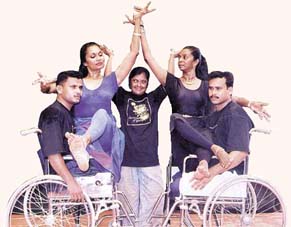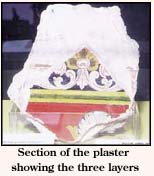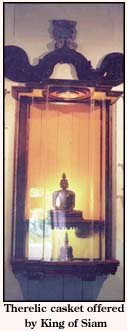
28th November 1999
News/Comment|
Editorial/Opinion| Business| Sports|
Sports Plus| Mirror Magazine


- A sacred display
- Kala Korner - by Dee Cee
- Blooming for a better tomorrow
- Making heads turn
- Health
- Temper your optimism - Thoughts from London
- Guess who's come to town?
- In search of practical solutions
- From schoolboy pranks to saga of triumph - Down Memory Lane
- Natural strokes
- Let's talk about sex
- Chipping in on history
- Timeless yet trendy
- Letters to the editor








The Sri Dalada Museum will be opened next year
A sacred display
By Hiranthi Fernando
A treasure trove of artifacts associated with the Dalada Maligawa will be opened to the public on the first full moon day in the new millennium. These priceless treasures dating from the period of the kings of Ceylon, were in storage in the Maligawa, under the care of the various Diyawadana Nilames, until recently.They have now been taken out of their wrappings, cleaned, polished, and displayed in all their splendour. This display, in a building within the precincts of the Dalada Maligawa, constitutes the Sri Dalada Museum.
"The idea for this museum came from the present Diyawadana Nilame, Neranjan Wijeratne, after he visited the Polonnaruwa Museum," said Prof. L. Prematilleke who has undertaken the task of planning and setting up the Sri Dalada Museum on a voluntary basis.
Prof. Prematilleke, the former Head of the Department of Archaeology at the University of Peradeniya, and Archaeological Director for the Cultural Triangle Project in Kandy and Polonnaruwa, was also responsible for setting up the Polonnaruwa Museum. The upper floors of the three storied building just behind the shrine room of the Maligawa have been selected for the museum. Each floor consists of a long high-roofed hall.
At the entrance to the Museum on the 1st floor, a floor plan of the Dalada Maligawa complex is enclosed in a glass case.
Prof. Prematilleke explained this ground plan was executed by a Dutchman in 1765.
The original of this plan is preserved in the Hague. He had obtained a photograph of the original and had it re- drawn by a local artist for display at the Museum.
The names of all the Mahanayakes of the Malwatte and Asgiriya Chapters and the Diyawadana Nilames, being joint custodians of the Sacred Tooth Relic, are listed along with their periods of service on a large board. Ranged along the hall are copper painted plaster cast busts of the Diyawadana Nilames, from the first in 1814- Kapuwatte Adikaram Nilame.
During the reign of the Kings, the king himself was the custodian of the Sacred Tooth Relic together with the Mahanayakes. Communications between the British Governors and the Kings too are displayed in glass cases. Among these is the Proclamation of the Kandyan Treaty of 1815.
Along the wall on one side of the hall is a photographic historical record detailing all the sites where the Tooth Relic was kept.
From the time of its arrival in Sri Lanka, during the reign of Kirti Sri Megavanna in the 4th Century A.D, the Tooth Relic was kept in various capitals according to tradition. At first the Relic was kept somewhere in the jungles between, Trincomalee and Anuradhapura. The rest of the wall shows the damages caused to the temple by the bomb blast on January 25, 1998, followed by the damage to the Natha Devale nearby.
 The
gold plated bronze pinnacle of the Paththirippuwa, which came down in the
blast is also on display.
The
gold plated bronze pinnacle of the Paththirippuwa, which came down in the
blast is also on display.
In glass showcases are some garments supposedly used by King Kirthi Sri Rajasinghe. Among these is a Hemakatha, (a pingo covered by frilled cloth somewhat like a skirt) worn by the king to carry the Bodhi Pooja to the shrine room. An ornate Ransivige offered to the temple by King Kirthi Sri Rajasinghe, in the latter half of the 18th Century is given a place of honour.
Prof. Prematilleke said although the shrineroom was miraculously undamaged in the bomb blast, the plaster of the wattle and daub walls had come down.
That exposed two older layers of paintings below the last layer of plaster which was done in 1942. The original layer was found to have been done by King Narendra Singh in the early 18th century.
A cross section of this plaster showing all three layers of paintings is also on display. Fragments of the murals of the uppermost layer as well as the innermost layer have been pieced together on canvas and displayed.
The paintings on the second layer are faded. Two sculptures in the Pallemale Viharaya on the right of the Pathirippuwa, which were broken by the bomb blast, have been touched up and now stand in the museum.
On the upper floor various items offered to the Dalada Maligawa throughout the centuries are on display.
Sorting out the offerings stored in the Maligawa, Prof. Prematilleke said they discovered a silver pot offered by King Kirti Sri Rajasinghe and a silver lamp offered by King Rajadhi Rajasinghe.
 "A
most important item in the museum is the relic casket offered from India,"
Prof. Prematilleke said.
"A
most important item in the museum is the relic casket offered from India,"
Prof. Prematilleke said.
"The relics in the small steatite casket were found in the ancient city of Taxila in Punjab, in a Buddha stupa believed to have been erected in the 1st Century B.C.
"The relic casket is enclosed in a gold plated miniature dagoba. The accompanying plaque states that the casket was 'presented by Baron Chelmsford, Viceroy and Governor General of India, to the Buddhists of Ceylon, to be enshrined in the Dalada Maligawa, in the 7th year reign of His Majesty King George V.'
"Equally important is the rolled up canvas we found, depicting the footprint of the Buddha," he said.
"During the reign of Kirti Sri Rajasinghe, Buddhism in the country was at a low ebb. A mission headed by Rev. Upali was sent to Siam to get monks to establish a higher order, the Siyam Nikaya.
"Rev. Upali returned with 21 monks to establish the nikaya. A canvas symbolizing the footprint of the Buddha was sent as an offering by the King of Siam.It is woven with golden threads, decorated with the auspicious marks of the Buddha in the Thai style. The original is still worshipped by the Royal Family in the Palace in Thailand.
"They consider the footprint as the palladium of the king," Prof. Prematilleke said.
"The seven-tiered pedestal on which the footprint is placed, signifies Mount Meru encircled by seven mountains. Placing the footprint on the summit symbolises the universality of the Buddha Dhamma."
A beautifully decorated, glass-domed casket was also an offering of the King of Siam. When the Sacred Tooth Relic is taken out to the pavilion for exposition, it is placed in this casket.
Well executed copies of the War Standard of King Sri Wickrema Rajasinghe and his Kandyan Flag, which were taken away by the British in 1803 too are exhibited in the museum.
"These were kept in the Royal Hospital in London," Prof. Prematilleke said.
"I visited the hospital and saw the flags. They were faded and only the cloth was seen. Fortunately however, in 1835, a painting of the flags had been done by an artist in London. We got photographs of this painting and a local artist reproduced them. In the Kandyan flag displayed it is seen that the lion is holding a whip and not a sword."
Another example of the skill of our local craftsmen is seen in a plaster cast copy of a Buddha statue, the original of which is in the Royal Scottish Museum in Edinburgh. The statue is said to have been found in a temple near the king's palace.
Among the exhibits are a variety of valuable items offered to the temple by devotees as well as visiting dignitaries. Offerings over the years, have contributed an impressive array of antique jewellery, gem-studded and of heavy silver.
Coins of many countries have been offered by foreign visitors. Buddha images, Bodhi trees, betel trays, chunam boxes, oil lamps, vases of all shapes and sizes, are some of the other items to be seen.
Ritual equipment connected with the Dalada Pooja, such as fans, chowries, tied to the tusker's ears and used to fan the Tooth Relic, fire-brands, incense burners and drums used in the temple services had been presented as votive offerings.
A collection of ola leaf manuscripts is also displayed. Records of significant donations, commemorated on bronze or copper plaques are of historical interest. The inscriptions on one plaque connect it with Danta and Hemamala, who brought the sacred Tooth Relic to Sri Lanka. The handing over of the Pathirippuwa to the Maligawa by Prime Minister Dudley Senanayake in 1966 is recorded on a bronze plaque.
The Sri Dalada Museum reflects the history and function of the Dalada Maligawa over the years. It is a welcome move to exhibit these treasures so that their significance could be appreciated by the people.
![]()
Front Page| News/Comment| Editorial/Opinion| Plus| Business| Sports| Sports Plus| Mirror Magazine
Please send your comments and suggestions on this web site to

